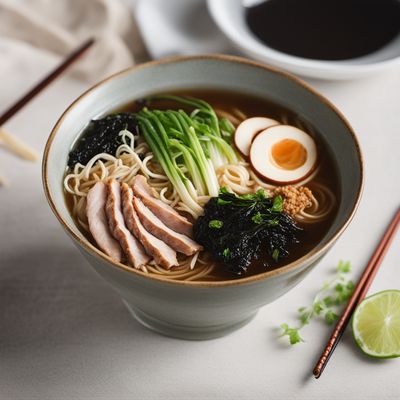
Recipe
Feijoada Adapted to Japanese Cuisine
Sakura Feijoada: A Japanese Twist on a Brazilian Classic
4.8 out of 5
In the context of Japanese cuisine, this adapted Feijoada recipe combines the rich flavors of Brazil with the delicate and balanced tastes of Japan. This fusion dish brings together the heartiness of Feijoada and the elegance of Japanese ingredients, resulting in a unique and satisfying culinary experience.
Metadata
Preparation time
20 minutes
Cooking time
40 minutes
Total time
60 minutes
Yields
4 servings
Preparation difficulty
Medium
Suitable for
Pescatarian, Dairy-free, Gluten-free, Nut-free, Low-carb
Allergens
Soy, Sesame
Not suitable for
Vegan, Vegetarian, Paleo, Keto, High-protein
Ingredients
While the original Feijoada is a hearty stew made with black beans, pork, and various meats, this adapted version incorporates Japanese ingredients and flavors. The traditional Brazilian seasonings are replaced with Japanese spices and herbs, and the dish is served with a side of pickled vegetables and steamed rice, reflecting the Japanese culinary style. We alse have the original recipe for Feijoada (Brazil), so you can check it out.
-
2 cups (470ml) cooked adzuki beans 2 cups (470ml) cooked adzuki beans
-
1 cup (240ml) dashi broth 1 cup (240ml) dashi broth
-
8 ounces (225g) pork belly, sliced 8 ounces (225g) pork belly, sliced
-
4 ounces (115g) smoked sausage, sliced 4 ounces (115g) smoked sausage, sliced
-
4 ounces (115g) chicken thighs, boneless and skinless, cut into bite-sized pieces 4 ounces (115g) chicken thighs, boneless and skinless, cut into bite-sized pieces
-
1 onion, chopped 1 onion, chopped
-
2 cloves garlic, minced 2 cloves garlic, minced
-
1 tablespoon soy sauce 1 tablespoon soy sauce
-
1 tablespoon mirin 1 tablespoon mirin
-
1 tablespoon miso paste 1 tablespoon miso paste
-
1 teaspoon ginger, grated 1 teaspoon ginger, grated
-
1 teaspoon sesame oil 1 teaspoon sesame oil
-
1 teaspoon vegetable oil 1 teaspoon vegetable oil
-
Salt and pepper to taste Salt and pepper to taste
Nutrition
- Calories (kcal / KJ): 450 kcal / 1880 KJ
- Fat (total, saturated): 25g, 8g
- Carbohydrates (total, sugars): 30g, 5g
- Protein: 25g
- Fiber: 8g
- Salt: 2g
Preparation
-
1.Heat vegetable oil in a large pot over medium heat. Add the pork belly and cook until browned.
-
2.Add the smoked sausage, chicken thighs, onion, and garlic to the pot. Cook until the onion is translucent and the chicken is cooked through.
-
3.In a small bowl, mix together soy sauce, mirin, miso paste, ginger, and sesame oil. Add this mixture to the pot and stir well.
-
4.Pour the dashi broth into the pot and bring to a simmer. Add the cooked adzuki beans and season with salt and pepper to taste.
-
5.Reduce the heat to low and let the Feijoada simmer for about 30 minutes, allowing the flavors to meld together.
-
6.Serve the Sakura Feijoada hot with steamed rice and pickled vegetables on the side.
Treat your ingredients with care...
- Adzuki beans — Make sure to cook the adzuki beans until they are tender but not mushy. Soaking them overnight before cooking can help reduce the cooking time.
- Dashi broth — If you can't find dashi broth, you can substitute it with vegetable broth or chicken broth for a slightly different flavor profile.
- Miso paste — Use a good quality miso paste for the best flavor. White or red miso will work well in this recipe.
Tips & Tricks
- For a smoky flavor, you can add a small amount of bonito flakes or smoked bonito powder to the dish.
- If you prefer a spicier Feijoada, you can add a pinch of shichimi togarashi (Japanese seven spice) or chili flakes.
- Garnish the dish with chopped green onions or cilantro for added freshness.
- Leftover Sakura Feijoada can be stored in the refrigerator for up to 3 days and reheated before serving.
- Serve the Feijoada with a side of Japanese pickles or tsukemono to add a tangy and crunchy element to the meal.
Serving advice
Serve the Sakura Feijoada hot with steamed rice on the side. Garnish with chopped green onions or cilantro for added freshness.
Presentation advice
To enhance the presentation, arrange the sliced pork belly, smoked sausage, and chicken thighs on top of the Feijoada stew. Sprinkle some sesame seeds and drizzle a little sesame oil over the dish for an attractive finishing touch.
More recipes...
For Feijoada (Brazil) » Browse all
For Brazilian cuisine » Browse all
More Brazilian cuisine dishes » Browse all

Palmito guisado
Hearts of Palm Stew
Palmito guisado is a traditional Brazilian dish that is made with hearts of palm, tomatoes, onions, and spices. The dish is light and flavorful,...

Pavê
Pavê is a traditional Brazilian dessert that is made of layers of cookies or cake and cream. It is a popular dessert that is often served during...

Pastel
Pastel is a savory pastry that originated in Brazil and is popular throughout South America. It is typically made with a filling of ground beef,...
More Japanese cuisine dishes » Browse all

Satsuma-age
Satsuma-age is a traditional Japanese dish that is made with fish that is mixed with flour and seasonings and then deep-fried. It is a popular...

Hiyayakko
Hiyayakko is a popular Japanese dish that is made with cold tofu. It is a simple and refreshing dish that is perfect for a hot summer day....

Wakame gunkan maki
Seaweed Salad Gunkan Maki
Wakame gunkan maki is a type of sushi that is made with small, oval-shaped mounds of sushi rice wrapped in a strip of nori seaweed and topped with...










